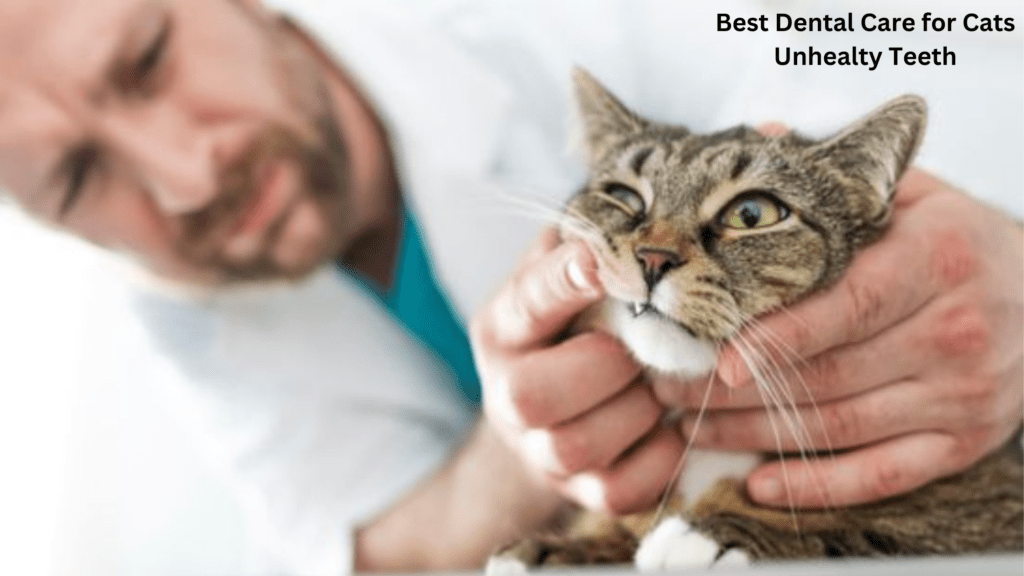Introduction:
The importance of Dental Care for Cats is necessary. unhealthy cat teeth can lead to various dental issues and overall health problems for your feline friend. Here are some signs of unhealthy cat teeth:
Bad breath
Tartar and plaque buildup
Red and swollen gums
Tooth discoloration or visible damage
Difficulty eating or chewing.

Bad Breath:
Bad breath, also known as halitosis, can be a common sign of dental problems in cats. However, it’s essential to note that bad breath can also be caused by other factors, such as gastrointestinal issues or certain diseases. The importance of Dental Care for Cats is important for gums Here are some potential causes of bad breath in cats:
Dental Issues:
The most common cause of bad breath in cats is dental problems, including gum disease (gingivitis and periodontal disease), tooth decay, or infected teeth. Bacteria in the mouth can produce foul-smelling gases, leading to bad breath.
Diet:
Certain foods can contribute to bad breath in cats. Poor-quality or inappropriate diet, such as foods with strong odors or high in fish, can cause unpleasant breath.
Oral Infections:
Infections in the mouth, such as oral ulcers or abscesses, can produce a foul odor.
Systemic Diseases:
Some underlying medical conditions, such as kidney disease, liver disease, diabetes, or respiratory infections, can lead to bad breath in cats.
Poor oral Hygiene:
Inadequate dental care, including infrequent teeth brushing or lack of professional cleanings, can contribute to bad breath.
Tartar and Plaque Buildup:
Tartar and plaque buildup are common dental issues in cats and can contribute to various oral health problems. Here’s some information about tartar and plaque in cats:
Plaque:
Plaque is a sticky film composed of bacteria, saliva, and food particles that form on the teeth. It starts accumulating shortly after eating. If not removed through regular brushing or chewing on abrasive materials, plaque can harden and turn into tartar.
Tartar (dental calculus):
Tartar is the hardened form of plaque that adheres tightly to the teeth. It has a yellow or brown color and a rough texture. Tartar provides a rough surface where more plaque can accumulate, leading to further dental problems.
Dental Problems Associated with Tartar and Plaque:
When tartar and plaque accumulate on the teeth, they can cause several oral health issues for Male And Female Kittens including:
Gingivitis:
Plaque and tartar irritate the gums, leading to inflammation and gingivitis. Signs may include redness, swelling, and bleeding of the gums.
Periodontal Disease:
If left untreated, gingivitis can progress to periodontal disease, which involves the destruction of the tissues supporting the teeth. This can lead to tooth loss and more severe complications.
Tooth Decay:
Plaque and tartar can contribute to tooth decay (cavities) in cats, especially in areas where the teeth are tightly packed together.
Oral Infections:
Tartar and plaque can provide a breeding ground for bacteria, which can lead to oral infections, abscesses, and other complications.
Red and Swollen Gums:
Red and swollen gums in cats can be a sign of gingivitis or periodontal disease. Here’s some information about red and swollen gums in cats:
Gingivitis:
Gingivitis refers to inflammation of the gums. It occurs when plaque and tartar build up along the gum line, leading to bacterial growth and irritation. The gums may appear red, swollen, and sensitive. Other signs of gingivitis include bad breath, bleeding gums, and reluctance to eat.
Periodontal Disease:
If left untreated, gingivitis can progress to periodontal disease. Periodontal disease involves the destruction of the structures supporting the teeth, including the gums, ligaments, and jawbone. In addition to red and swollen gums, you may notice receding gums, loose teeth, and dental abscesses.
Causes of Gum Inflammation:
Besides dental issues, other factors can contribute to red and swollen gums in cats, including:
Trauma or injury to the gums
Infections, such as feline or herpesvirus
Autoimmune conditions affecting the gums
Nutritional deficiencies
Certain systemic diseases, like kidney disease or diabetes
Tooth Discoloration or Visible Damage:
Tooth discoloration or visible damage in cats can indicate dental decay, injury, or other dental problems. The importance of Dental Care for Cats is necessary for teeth. Here’s some information about tooth discoloration and visible damage in cats:
Dental Decay (cavities):
Cats can develop dental caries, commonly known as cavities. Cavities can cause tooth discoloration, usually appearing as brown or black spots or areas on the teeth. If left untreated, dental decay can progress and lead to more severe dental issues.
Tooth Fractures or Chipping:
Cats may experience tooth fractures or chipping due to trauma, chewing on hard objects, or underlying dental problems. These fractures or chips can result in visible damage to the tooth, such as broken or missing parts.
Enamel Hypoplasia:
Enamel hypoplasia is a condition where the tooth enamel is thinner or improperly formed. It can lead to tooth discoloration, ranging from white or yellowish spots to brown or black staining.
Pulp Exposure:
Severe dental decay or trauma can cause damage to the tooth, resulting in pulp exposure. Pulp exposure may lead to discoloration of the affected tooth and can cause pain and sensitivity.
Discoloration Due to Other Factors:
Tooth discoloration in cats can also be caused by other factors such as stains from certain medications or ingested substances, certain diseases, or systemic health issues.
Difficulty Eating or Chewing:
If your cat is having trouble eating or chewing, it can be a sign of dental problems or other underlying health issues.
Dental Problems:
Dental issues, such as dental decay, gum disease, oral infections, fractured teeth, or abscesses, can cause pain and discomfort while eating or chewing. Cats may show reluctance to eat, drop food, chew on one side of the mouth, or paw at their mouth.
Oral Tumors or Growths:
In some cases, oral tumors or growths can develop in cats, affecting their ability to eat or chew properly. These growths may cause pain, difficulty in opening the mouth, or obstruction of the oral cavity.
Jaw Injuries:
Trauma or injuries to the jaw can lead to difficulty in opening or closing the mouth, causing challenges in eating or chewing.
Oral Inflammation or Infections:
Inflammation or infections in the oral cavity, such as stomatitis or oral ulcers, can cause discomfort and make eating or chewing painful for cats.
Systemic Health Issues:
Certain systemic health conditions, like kidney disease or oral manifestations of diseases like feline immunodeficiency virus (FIV), can also affect a cat’s ability to eat or chew comfortably.
FAQs
How often should I brush my cat’s teeth?
Regular tooth brushing is an essential part of maintaining good oral health in cats. Aim to brush your cat’s teeth at least 2-3 times a week. It’s best to start the habit when your cat is young, but with patience and gradual introduction, even older cats can learn to tolerate tooth brushing.
Can we use human toothpaste for my cat’s teeth?
No, you should never use human toothpaste for cats. Human toothpaste contains ingredients, such as fluoride and foaming agents, that can be harmful if swallowed by cats. Instead, use toothpaste specifically formulated for cats, which is safe to swallow and comes in flavors appealing to them.
Are dental treats and toys effective for maintaining dental health in cats?
Dental treats and toys can be beneficial for your cat’s dental health. They help promote chewing and provide a mild abrasive action that can help reduce plaque and tartar buildup. Look for products that have the Veterinary Oral Health Council (VOHC) seal, indicating they meet certain standards for effectiveness.
Can bad breath in cats be a sign of a serious health problem?
Yes, bad breath in cats can sometimes be a symptom of underlying health issues. It’s particularly important to be vigilant if the bad breath is accompanied by other signs like excessive drooling, weight loss, changes in appetite, or lethargy. In such cases, it’s best to consult with a veterinarian to rule out any serious health concerns.
How often should we take my cat for professional dental cleanings?
The frequency of professional dental cleanings for cats depends on their individual dental health. In general, most cats will benefit from professional cleanings once a year or as recommended by your veterinarian. However, some cats with significant dental issues may require more frequent cleanings.
Conclusion:
In conclusion, maintaining good dental health in cats is crucial for their overall well-being. Bad breath in cats can be a symptom of various underlying unhealthy cat teeth issues or health problems. Regular dental care, including tooth brushing, dental diets or treats, and professional dental cleanings, can help prevent and manage dental problems such as tartar and plaque buildup, gum disease, and tooth decay. It’s important to consult with a veterinarian if you notice bad breath, red or swollen gums, tooth discoloration, or difficulty eating or chewing in your cat. The veterinarian can perform a thorough examination, provide a diagnosis, and recommend appropriate treatment options to address the underlying causes and improve your cat’s oral health. By prioritizing dental care and seeking veterinary guidance, you can help ensure your cat enjoys a healthy and fresh-smelling mouth. The importance of Dental Care for Cats is necessary.



